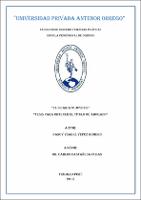Mostrar el registro sencillo del ítem
El sicariato juvenil
| dc.contributor.advisor | Castañeda Cubas, Carlos | |
| dc.contributor.author | Yepez Romero, Nancy Ysabel | |
| dc.creator | Yepez Romero, Nancy Ysabel | |
| dc.date.accessioned | 2016-09-02T17:30:13Z | |
| dc.date.available | 2016-09-02T17:30:13Z | |
| dc.date.issued | 2015 | |
| dc.identifier.uri | https://hdl.handle.net/20.500.12759/1821 | |
| dc.description.abstract | Los medios de comunicación a nivel nacional y regional informan que ha crecido considerablemente los homicidios por encargo cometidos por menores de edad, modalidad que se conoce con el nombre de sicariato y que según cifras de la autoridad policial del departamento de La Libertad, el 40% de homicidios en la región corresponden a ésta modalidad. En esta investigación indagamos las cifras oficiales que nos permitan determinar la cantidad de homicidios perpetrados por menores de edad infractores e intentar responder a la pregunta ¿cuáles son las principales causas motivadoras que impulsan a un menor de edad a ejecutar actos de muerte como si fuera una empresa comercial? La respuesta es variada, interviniendo muchos factores entre los que podemos destacar, la desorganización familiar, la educación deficiente, la deserción escolar, el consumo de drogas, la falta de control de los padres, la posesión de dinero que lo utilizan en actos de naturaleza negativa, como el consumo de alcohol, drogas, mujeres, las existencia de mafias, todo ello contribuye a la existencia de este fenómeno social denominado sicariato juvenil. Las teorías más frecuentemente que explican la presencia de este fenómeno son la del etiquetamiento o reacción social, tensión, frustración, desadaptación, falta de madurez, subcultura, cambio social y desviación, entre otras. Unas tienen una condición médico psicológica; otras, sociológica; y algunas son combinación de ambos enfoques. Todas estas teorías son eminentemente descriptivas-explicativas en las que se muestra un panorama poco alentador en cuanto al intento resocializador, pues en su totalidad puntualizan en el efecto irreversible de las causas, lo que explicaría la subsiguiente carrera criminal del menor al llegar a la edad adulta. La criminalidad organizada se convierte en un factor de riesgo determinando el inicio de las actividades delictivas de los menores infractores, ofreciendo oportunidades de posición social y económica, sumado a las condiciones familiares, educativas y de pertenencia a grupos amicales tendientes a infringir la ley desencadena actividades ilícitas por encargo los que incluyen atentar contra la vida a cambio de una retribución previamente pactada. | es_PE |
| dc.description.abstract | The media at national and regional levels report that has grown considerably custom killings committed by minors, modality that is known assassination and that according to figures from the police authority of the department of La Libertad, 40% of homicides in the region corresponding to this mode. In this study we investigated the official figures that allow us to determine the number of homicides committed by juvenile offenders and try to answer the question what are the main motivating causes that drive a child to death execute acts like a commercial enterprise? The answer is varied, speaking many factors among which we highlight, family disorganization, poor education, truancy, drug use, lack of parental control, possession of money they use in acts of nature negative, such as alcohol, drugs, women, the existence of mafias, all contribute to the existence of this social phenomenon called juvenile killings. The most common theories that explain the presence of this phenomenon is that of labeling or social reaction, tension, frustration, maladjustment, lack of maturity, subculture, social change and deviation, among others. Some have a psychological medical condition; other, sociological; and some are a combination of both approaches. All these theories are eminently descriptive-explanatory in which a bleak picture shown in terms of re-socializing intent, for fully clarified in the irreversible effect of the causes, which would explain the subsequent criminal career of the child to reach the age adult. Organised crime becomes a risk factor determining the start of the criminal activities of juvenile offenders, providing opportunities for social and economic position, joined the family, educational and membership conditions amicales groups aimed to break the law triggers activities custom illicit which include life threatening exchange for a previously agreed fee. | en_US |
| dc.description.uri | Tesis | es_PE |
| dc.format | application/pdf | es_PE |
| dc.language.iso | spa | es_PE |
| dc.publisher | Universidad Privada Antenor Orrego - UPAO | es_PE |
| dc.rights | info:eu-repo/semantics/openAccess | es_PE |
| dc.source | Repositorio Institucional UPAO | es_PE |
| dc.source | Universidad Privada Antenor Orrego | es_PE |
| dc.subject | Sicariato Juvenil | es_PE |
| dc.title | El sicariato juvenil | es_PE |
| dc.type | info:eu-repo/semantics/bachelorThesis | es_PE |
| thesis.degree.level | Titulo Profesional | es_PE |
| thesis.degree.grantor | Universidad Privada Antenor Orrego. Facultad de Derecho y Ciencias Politicas | es_PE |
| thesis.degree.name | Abogada | es_PE |
| thesis.degree.discipline | Derecho | es_PE |
Ficheros en el ítem
Este ítem aparece en la(s) siguiente(s) colección(es)
-
Derecho [422]

